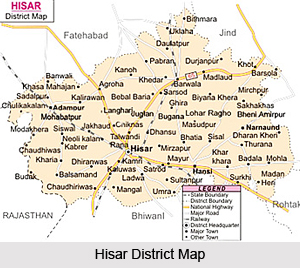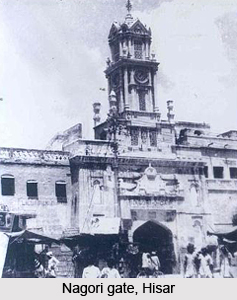 Hisar District was the largest district in Haryana till its reorganisation. Later, some parts of it were transferred to Jind District in 1966 when it was made a new district. Tehsil Bhiwani and Loharu estate were transferred to Bhiwani District when Bhiwani was carved out in the year 1974. It was further bifurcated when Sirsa became a new district out of Hisar District. Later, Fatehabad District has been carved out of this district. Hisar town is the administrative headquarters. The present city of Hisar, one of the important cities of North India, is located at 29 degree 5 minutes 5 second north latitude and 75 degree 45 minutes 55 second east longitudes.
Hisar District was the largest district in Haryana till its reorganisation. Later, some parts of it were transferred to Jind District in 1966 when it was made a new district. Tehsil Bhiwani and Loharu estate were transferred to Bhiwani District when Bhiwani was carved out in the year 1974. It was further bifurcated when Sirsa became a new district out of Hisar District. Later, Fatehabad District has been carved out of this district. Hisar town is the administrative headquarters. The present city of Hisar, one of the important cities of North India, is located at 29 degree 5 minutes 5 second north latitude and 75 degree 45 minutes 55 second east longitudes.
History of Hisar District
Hisar was founded by Firoz Shah Tughlaq in 1354 AD. `Hisar` is an Arabic word which means `Fort.` Hisar was originally called `Hisar Firoza`, which meant `Fort of Firoz`. It was in these lands that the very first evidence of the presence of man was discovered with the excavation of Agroha, Banawali and Kunal. All of these were the pre-Harappan settlements. The construction work of Hisar was started in the year 1354 AD. The fort city was also surrounded by big ditch dug round the wall. Inside the fort a fine palace, having a complex of different buildings was built.
 Well laid out gardens added to the beauty of the palace. The initial stage of the city, it was reported, was completed after the incessant work of two and a half years. Further, the fort-city had four gates which were subsequently named as the Delhi Gate and Mori Gate to the east, the Nagori Gate to the south and Talaqi Gate to the west.
Well laid out gardens added to the beauty of the palace. The initial stage of the city, it was reported, was completed after the incessant work of two and a half years. Further, the fort-city had four gates which were subsequently named as the Delhi Gate and Mori Gate to the east, the Nagori Gate to the south and Talaqi Gate to the west.
In 1408, Hisar fell into the hands of the rebels. In 1411, the tract of Hansi came into the hands of Khizar Khan, and he ascended the throne of Delhi in 1414 as the first Sultan of Sayyid Dynasty. During the weak dynasty of the Lodhis (1451-1526) Hisar continued to form parts of Haryana and was granted as a fief to Muhabbat Khan in the reign of Bahlul Lodi (1451-1489). When Babur invaded India in the 1524-26, Hisar was an important strategic centre of the empire of Ibrahim Lodi. Babur handed over the city of Hisar to Humayun as a reward for his success in his first military expedition. During the reign of Akbar (1556-1605), Hisar became once more a place of considerable importance.
Geography of Hisar District
Hisar District generally has very hot summers and very cold winters. The maximum day temperature during the summer varies within 40 degree to 46 degree Celsius. During winter it ranges between 1.5 degree and 4 degree Celsius. The winds are strong and frequent during May to July. Normally the south westerly current of summer monsoon brings the rains during July to September period. Intermittent dust storms are also common here.
Administration of Hisar District
Administration of Hisar District consists of four tehsils and three sub-tehsils. The tehsils are Hisar, Hansi, Narnaund and Adampur and sub tehsils are Barwala, Uklana and Bass. Hisar is a divisional headquarters of the Divisional Commissioner and also the headquarters of Police Range. It is also the battalion headquarters of Border Security Force.
Hisar gained importance in early sixties when Agriculture University was setup as an extension of the Punjab Agricultural University, Ludhiana.






